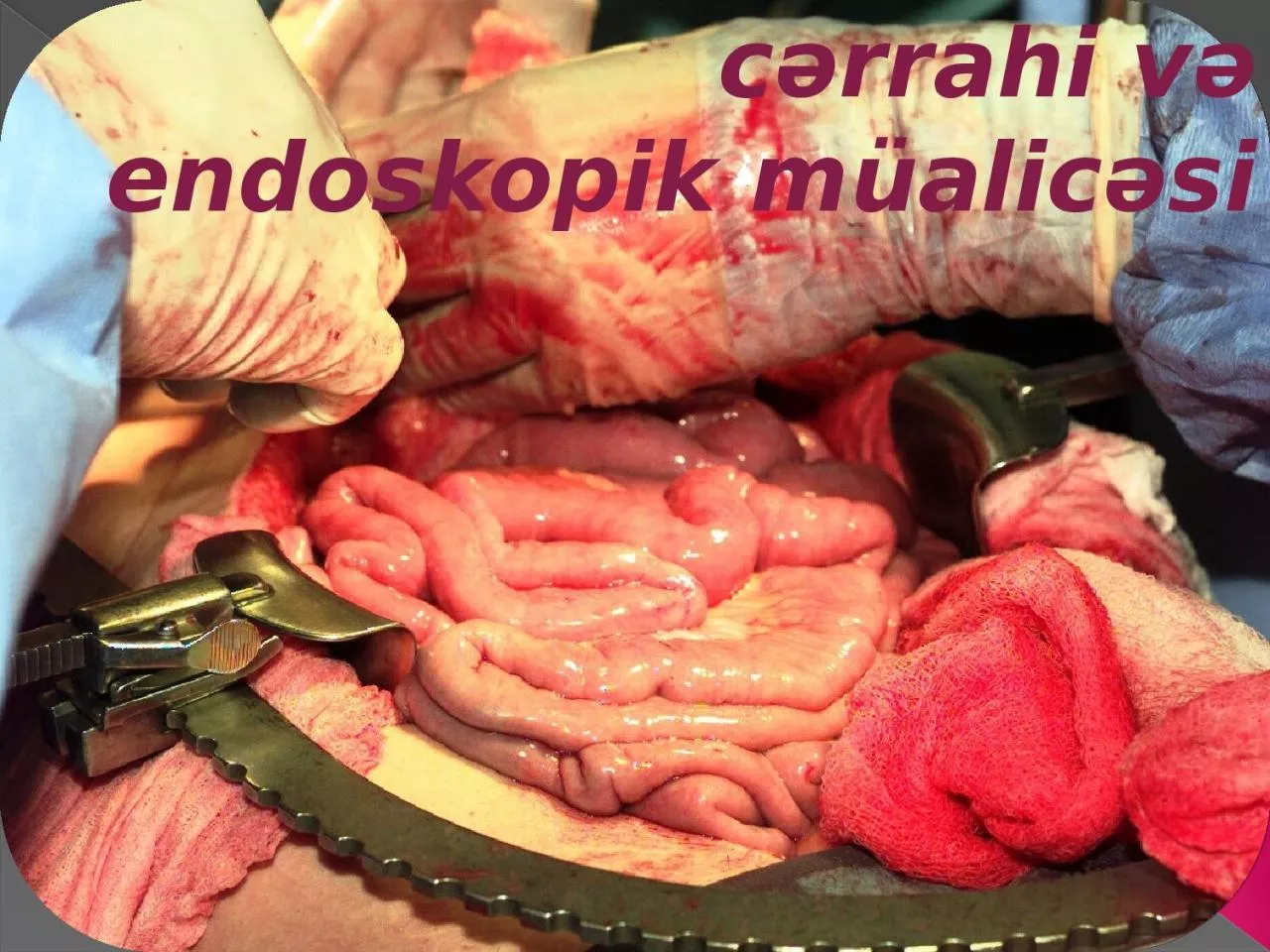

Rectum Bleeding Altered bowel habit Tenesmus Pain Bladder symptoms Caecum Anaemia Obstruction Mass Dyspepsia Appendicitis Symptoms of Colorectal Cancer Type 1 ID: 1040961
Download Presentation The PPT/PDF document "Kolorektal kanserin cərrahi və endosko..." is the property of its rightful owner. Permission is granted to download and print the materials on this web site for personal, non-commercial use only, and to display it on your personal computer provided you do not modify the materials and that you retain all copyright notices contained in the materials. By downloading content from our website, you accept the terms of this agreement.
1. Kolorektal kanserin cərrahi və endoskopik müalicəsi
2. RectumBleedingAltered bowel habitTenesmusPainBladder symptomsCaecumAnaemiaObstructionMassDyspepsiaAppendicitisSymptoms of Colorectal Cancer
3. Type 1 Type 2 Type 3 Type 4 Macroscopic types of advanced colorectal carcinomaType 1 lesion, protuberant tumor with fold convergenceType 2 lesion, showing an irregular ulceration and clear marginal swellingType 3 lesion, showing an irregular ulceration and unclear marginal swellingType 4 lesion, showing an irregularly edematous mucosa with luminal stenosis due to diffuse infiltration, Ulceration is not pointed out on the lesion.Fig. 2. Endoscopic view of each type of advanced colorectal carcinoma
4. Known as “cancer in situ,” meaning the cancer is located in the mucosa (moist tissue lining the colon or rectum)Removal of the polyp (polypectomy) is the usual treatmentStage 0 Colorectal Cancer
5. Removing early stage tumours
6. Stage I Colorectal CancerThe cancer has grown through the mucosa and invaded the muscularis (muscular coat)Treatment is surgery to remove the tumor and some surrounding lymph nodes
7. Stage II Colorectal CancerThe cancer has grown beyond the muscularis of the colon or rectum but has not spread to the lymph nodesStage II colon cancer is treated with surgery and, in some cases, chemotherapy after surgeryStage II rectal cancer is treated with surgery, radiation therapy, and chemotherapy
8. Stage III Colorectal CancerThe cancer has spread to the regional lymph nodes (lymph nodes near the colon and rectum)Stage III colon cancer is treated with surgery and chemotherapyStage III rectal cancer is treated with surgery, radiation therapy, and chemotherapy
9. Stage IV Colorectal CancerThe cancer has spread outside of the colon or rectum to other areas of the bodyStage IV cancer is treated with chemotherapy. Surgery to remove the colon or rectal tumor may or may not be doneAdditional surgery to remove metastases may also be done in carefully selected patients
10. Trans anal resection
11. Colectomy - hemicolectomy
12. Hot biopsyPolypectomy snare
13. Endoscopic submucosal resection (EMR)
14. Method of ESDFirst, the borders of the tumors are determined by chromoendoscopy with indigo carmine spraying for enhanced or magnified observation using NBI. Marking around the tumor is not necessary in most cases because colorectal neoplasms typically have clear margins. The use of 0.4% sodium hyaluronate solution for submucosal injection keeps the tumor lifted for long periods (Yamamoto, 1999). Next, the mucosal incision in front of the tumor is made with a short needle knife such as FlushKnife BTTM (1.5 mm; Fujifilm Corp., Tokyo, Japan) (Fig.17). Only the needle part should be used for the incision, keeping the tip of the sheath touching the surface of the mucosa without pushing the sheath into the submucosal layer. We use the endcut mode of electric surgical unit for the mucosal incision.
15. Method of ESDESD using FlushKnife BTTM for rectal mucosal carcinoma of 80mm in diameter ESD using Clutchcutter™ (Fujifilm Corp., Tokyo, Japan)After repeated submucosal injection, submucosal dissection is performed parallel to the muscular layer by sliding the knife from the center to the side while hooking submucosal fibers with the knife. We use the swift coagulation mode of electric surgical unit at this time. When thick vessels can be observed in the submucosal layer, grasping and soft coagulation are performed using coagulation forceps. Furthermore, a surrounding incision is made, and submucosal dissection is performed while lifting up the dissected part of the tumor with the edge of the transparent cap at the tip of the scope. Finally, hemostasis and the lack of a weak point of the muscularis propria are confirmed after resection.
16.
17.
18.
19.
20. Ich danke Ihnen für die Aufmerksamkeit!